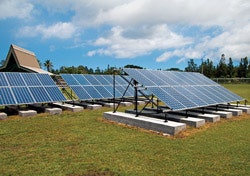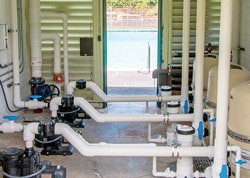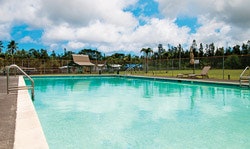There are countless community pools in North America like the one at Hawaiian Shores, a subdivision south of Hilo on the Big Island of Hawaii.



There are countless community pools in North America like the one at Hawaiian Shores, a subdivision south of Hilo on the Big Island of Hawaii. It's of modest size (110,000 gallons) and ordinary shape, and draws a crowd on weekends like any other.
But there's something unique about this pool - all of the power to drive its filtration pumps comes from the sun. It's the first such installation in the Northern hemisphere, according to Michael Moylan, president of Pacific Solar Products, the Hawaiian distributor for the photovoltaic pumping system.
While the term "solar power" is often used in the pool industry, it typically refers to passive solar heating of pool water, in which water runs through black, radiant-heat-absorbing tubes and back into the pool. There are some solar pumps on backyard pools, as well, but using sunlight to create electric current sufficient to drive the filtration pumps of a commercial-size pool, with no backup - that's new.
"On the residential side, we've been taking swimming pools completely off the grid for years, and there are solar-assisted pumps for commercial pools and private pools," Moylan says. "But taking a commercial swimming pool completely off the grid with no AC backup at all has only been done once, in Cyprus."
The case for solar
As with many solar-power stories, this one begins with a utility bill. The entire State of Hawaii pays a lot for electricity; it's about $0.41 per kWh on the Big Island. The Hawaiian Shores Community Association (HSCA) was paying roughly $1,000/month to run a 10-horsepower, three-phase motor. Board president Eileen O'Hara liked the idea of going green and reducing that monthly cost to zero. The critical figure in all such decisions is return on investment, which in this case was calculated to be eight or nine years.
The payback period was longer than normal due to HSCA's nonprofit status, which rendered it ineligible for the state and federal income tax credits that are usually applied to solar electric installations. The board still felt the case for solar was strong enough.
With the go-ahead from the association, project engineering began. The HSCA changeover from utility-based power to solar power was a practical design challenge from the start. For this phase, Tyson Toyama of the engineering firm Okahara & Associates was brought in to figure out exactly how to make solar technology achieve what local government demanded. "We asked him to take a completely different approach to meeting or exceeding the health department's requirements for water circulation and purification in a public pool," Moylan says.
Of crucial importance in that effort and, indeed, to the feasibility of the entire project, was the HSCA pool's exemption from the usual requirement for commercial pools that water be kept moving at night, when solar pumps grind to a halt. "This particular pool does not have any lighting, and the association had gotten permission from the health department to turn off its pumps at night. They weren't running at night, even before we came. So we just kept that same schedule and changed the source of power," Toyama says.
Still, a six-hour turnover rate during operation was part of the design criteria, and the team needed to satisfy the authorities. To do that while relying on a variable source of power - that is, the amount of light shining down from the heavens - was a rousing challenge. "You've got to consider," Moylan says, "we're going 100 percent solar with no AC backup. What if it rains? Is the pool going to stop pumping? We had to get the data to convince them on that point. They're variable-speed pumps, so they slow down when it rains, but they still turn enough circulation in a six-hour timeframe to meet the health department's regulations."
Early morning hours and cloudy periods were the main problem. The team solved this by upsizing the solar panel array so that even in minimal sunlight conditions, the pumps deliver enough gallons per minute.
Okahara & Associates is pursuing other solar pump projects on the island, Toyama says, but with the much more common AC supplement. "We're looking at a pool now, a YWCA, that we wouldn't run 100 percent solar," he says. "It would be connected to the grid to run at night. We're not sure how we would approach it. On the Big Island, the excess power you generate from your solar panels during the day is sent back to the grid and, in effect, held for you to use at night. So we might do that."
Reduced Cost
By proving the feasibility of unassisted solar pumping, the HSCA pool serves as a major advance in the industry's effort to reduce the cost of pool ownership, which is crucial to future growth. The use of clean power is an added benefit that enhances the image of the industry as up-to-date, even forward-looking.
"This historic undertaking will lead to a whole new way of looking at solar energy and the many applications required in the transfer and movement of water," Moylan says. "We eliminated three-phase power on a commercial pool. That is now a possibility."




































